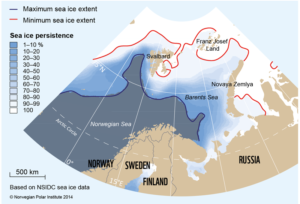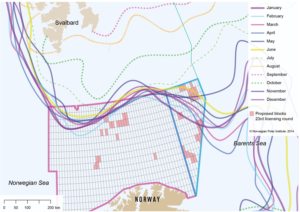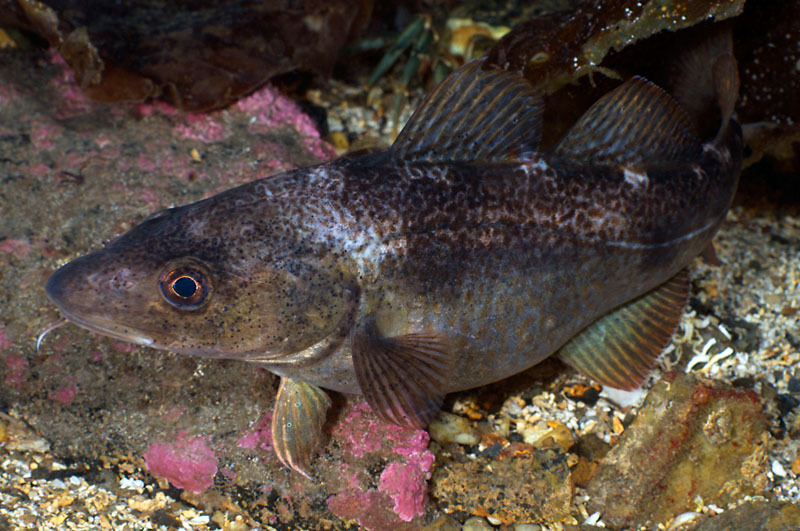This article is reprinted from The Circle 4.14. Dr. Jan-Gunnar Winther is a hydrologist and director of the Norwegian Polar. Dag Vongraven is a biologist and senior adviser at the Environmental and Mapping Department of the Norwegian Polar Institute. He also chairs the IUCN/SSC Polar Bear Specialist Group.
The ice edge is rarely a neat line. Rather, it comprises a dynamic zone of varying degrees of ice cover between open water and 100 per cent ice cover.
Dependent on current and wind conditions, it can change from being a fairly narrow, well-defined edge, to a swath of ice-floes tens of kilometres broad. It is in constant motion, moving north- or southwards during the seasons. The outer rim of the sea ice which is close enough to the open ocean boundary to be affected by its presence is often called the Marginal Ice Zone (MIZ) or the Sea Ice This zone of high biological production is particularly vulnerable to human impact. In addition to its role in moderating regional and global climate, sea ice needs to be taken into consideration when assigning new licenses for oil and gas prospecting in the Barents Sea.
For a few weeks in spring, the Sea Ice Zone becomes a hotbed of primary production, a blooming garden of plant plankton and ice algae.

Map showing maximum and minimum sea ice extent in the month of April in the years from 1984 to 2013, as well as ice persistence in 10% increments. Ice persistence is the frequency of April days with ice concentration greater than 15% in any given pixel/area in the material the maps is based on.
An important and vulnerable garden
For a few weeks in spring, the Sea Ice Zone becomes a hotbed of primary production, a blooming garden of plant plankton and ice algae. Zooplankton feed on these, and they in turn are prey for larger animals. From its outer edge and throughout the area where the light penetrates the ice cover, the Sea Ice Zone is more ecologically vulnerable than other parts of the ocean.
Primary production takes place across the world’s oceans, but nowhere is it as concentrated in time and space as in the Sea Ice Zone. A more predictable and denser patch of food than the open ocean, the Sea Ice Zone is an important feeding ground for a variety of animals, including ivory gulls, ringed seals, polar bears, narwhals, beluga and bowhead whales. Many of these are nationally or internationally protected and/or endangered species. The area provides crucial habitats and foraging areas for other key species in the Arctic ecosystem, such as capelin and polar cod, which are prey for other species of marine birds and mammals. It is also an important resting place for migrating species of marine birds and mammals – a biological hot spot.
A challenge for managing the Arctic
Many environmental values vary in time and space, as does the sea ice. Properly managing dynamic systems such as ice-covered waters is a substantial challenge. Diminishing sea ice presents opportunities for the expansion of human activities in the Arctic in the near future. Human influence may negatively affect stocks and populations of many Arctic species. Contributing to the integrated, knowledge-based management of the region, the Norwegian Polar Institute has recently assembled statistics on sea ice conditions in the Barents Sea and described the vulnerability of this area. The Institute also provides knowledge on ecosystems and physical conditions in the Arctic, including sea ice. It has described this zone based on satellite monitoring of the ice cover for the last 30 years (1984-2013) and produced maps to show variations in the timing and location of sea ice during each month of the year.

Monthly maximum sea ice extent for the period 1984-2013. Suggested licenses in the 23rd licensing round are shown as squares on the map.
The 23rd licensing round for oil and gas prospecting in the south-eastern part of the Barents Sea opens the door for petroleum activities further northwards than ever before. In a consultative statement to the Norwegian authorities, the Norwegian Polar Institute has pointed out the vulnerability of this region on account of the seasonal presence of sea ice and a general lack of knowledge of the area and its variability. The proposed hydrocarbon exploration areas will be closer to vulnerable seabird colonies on the island of Bjørnøya (Spitsbergen archipelago), closer to the maximum extent of sea ice, overlapping the Polar Front, in the south-eastern part of the Barents Sea and partly within areas which have been defined as particularly valuable and vulnerable in the Integrated Management Plan for the Norwegian Part of the Barents Sea and the Areas outside Lofoten.
The Institute has also highlighted the need for increased preparedness for oil spills and other accidents in the region.
